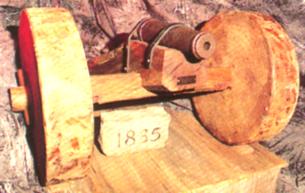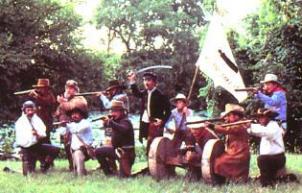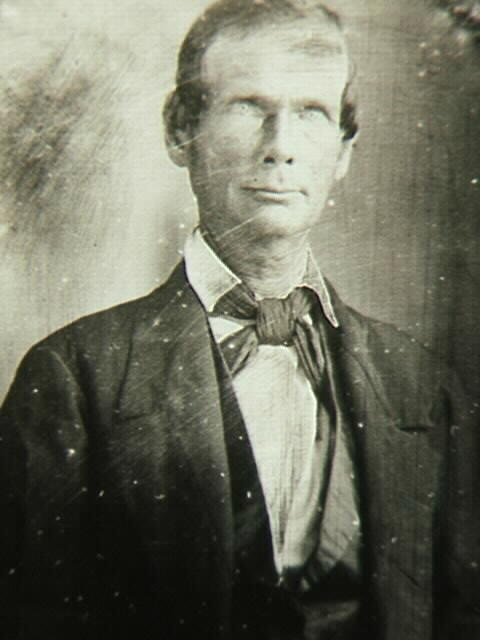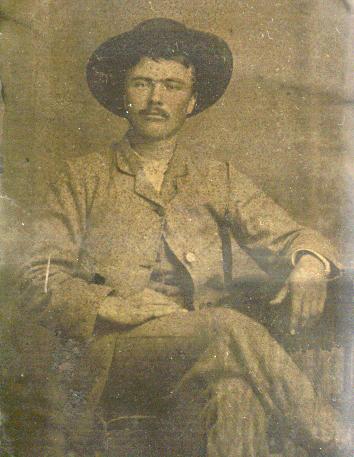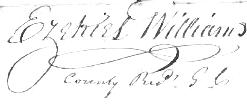SONS OF DEWITT COLONY TEXAS OLD GONZALES EIGHTEEN The uniqueness and significance of roles of the old eighteen relative to the 100-200 who participated in the confrontation at Gonzales is unclear. They are generally credited as stated on the Texas State Historical marker at the site on the Guadalupe River with delaying Lt. Castañeda's 150 dragoons for two days beginning 29 Sep while a sufficient Texan force could be assembled in Gonzales. In some abbreviated histories, it is implied that there was military confrontation between the 18 and the Mexican force and some imply that the 18 were the complete force that participated in what became known as the Battle of Gonzales or the "Texas Lexington." Communications from Officers Martin, Coleman and Moore to San Felipe and surrounding settlements on 30 Sep 1835 refer to the fact that on the 29th there were only 18 men in Gonzales, but by the 30th there were 150. One of Corporal DeLeon’s party that met Lt. Castañeda on the road to Gonzales on the 29th reported over 200 were in Gonzales by that time. It is likely that as a normal part of daily life of the period in the sparsely populated DeWitt Colony that there were 18 or less men able or willing to respond in Gonzales proper when the affair began with DeLeon's arrival on 25 Sep. From the records, it appears that the role of the original 18 was primarily one of lookouts and messengers of the movements of the Castañeda force on the west side of the Guadalupe rather than an armed resistance force. It is clear that with news of the arrival of regular Mexican army troops DeWitt Colony citizen-soldiers who were busy on their nearby farms and ranches were the first to rally in their capital municipality Gonzales. They were followed by a rapid response from settlements in the Austin Colony to the east and south. Overall, the affair was a confrontation over principle rather than an organized military action by either side, insurrection or counter-insurrection. However, the event symbolized the willingness of peace-loving, loyal Anglo-Mexican citizens to resist on the basis of principle the dictatorship, despotism and betrayal of their central Mexico City government. Subsequent events and resistance to the centralista government led to the independence of Texas. Consequently, the confrontation at Gonzales has become known as the Battle of Gonzales, the "Lexington" of the Texas Independence movement and the boom of the Gonzales cannon the "shot heard round the world from Texas." The eighteen DeWitt Colony residents of Gonzales whose biographies are summarized below have been immortalized as the Original 18 freedom fighters of the resistance movement that led to Texas Independence. Of the 18, Darst, Dickinson, Jackson, Martin and Miller participated in one or more subsequent confrontations with the centralistas before they became members of the Gonzales Alamo Relief Force and died in the Alamo on 6 Mar 1836. Cottle, Davis and Fuqua had multiple relatives who were in the relief force that died in the Alamo. Arrington, Clements, Davis, Miller, Turner and Williams served in the Gonzales Ayuntamientos. Besides those in the Alamo Relief Force, Bennet, Davis and Martin (died in Alamo) served in major roles in the Texas Republican Army for Independence. All participants were homestead and property owners. Dickinson, Fuqua, Sowell and Turner also owned businesses in Gonzales town. William W. Arrington is listed in DeWitt Colony land title records as arriving in the colony as a single man on 15 Feb 1831 where he received a fourth sitio of land on the east bank of the Guadalupe River in southern Guadalupe County. He married Jane E. Morrison and they had at least one daughter, Jennie Elizabeth Arrington who married John Duggan on 11 Dec 1870. The Arringtons owned lots 1 and 6 in block 15 and lot 4 in block 3 southeast of the Fort in the inner town of Gonzales. They had a home at the corner of St. James and St. Michaels in block 15. Arrington was the election judge on 1 Feb 1835 for the Texas consultation to be held in March 1835. He was a member of the Committee for Safety formed in response to dissolution of the legislature of Texas y Coahuila in May 1835. He was elected as one of the two delegates from Gonzales to the consultation of Oct 1835. Simeon Bateman (some records show Simon) received a sitio of land on the current Gonzales-DeWitt County line on the west bank of the Guadalupe River according to DeWitt Colony land records. He arrived in the colony married on 20 Feb 1831 with a "family of 38" according to land records as a part of the Tennessee-Texas Land Company contract from HardemanCo, TN. The exceptionally large number of his family indicates that he was one of the few slaveholders in the early years of the colony. Bateman was an obvious supplier of provisions to the Texian army from the Gonzales area and is mentioned often in the correspondence and records of the quartermaster department, particularly those of Capt. Mathew Caldwell, in the fall of 1835 and spring of 1836. One contract involved 10,000 pounds of pork. He is listed on the Gonzales tax rolls of 1837-39. Miles Bennet in his newspaper articles on the events leading up to the Battle of Salado in 1842 describes Bateman:
His will of 4 Aug 1843 states:
In an article from the Telegraph and Texas Register of 28 Jan 1845 Simeon Bateman was described as "one of the oldest and most wealthy settlers of Gonzales county." The research of L.W. Kemp [Dixon, Sam Houston and Kemp, Louis Wiltz. The Heroes of San Jacinto] relates the death of Simeon Bateman and James Matthew Jett as described in the memoirs of Jett's mother, Ms. William Jett (wife of Jett's brother):
Valentine Bennet is listed in DeWitt Colony land records as having arrived single on 1 April 1831 where he received a fourth league of land on the west bank of the Guadalupe in current DeWitt County above Cuero and is listed on the Gonzales tax rolls of 1838-39. Bennet owned two blocks in the west outer Gonzales town tract. He was born in Massachusetts in 1780 of Puritan background and lived in NY, OH and LA. He fought in the War of 1812 and was promoted at Lundys Lane in 1814 for gallantry. He married Mary Kibbe (daughter of Gaius and Mary Pease from Enfield, CT) 7 Oct 1817 in Buffalo, NY and came to St. Marys Parish, LA with the Kibbe family in 1820. Wife Mary and Mary Jane, one of their twin daughters, died there in 1821. Bennet took surviving children, Sarah Jane and Miles Squier to Ohio and left them with relatives while he went to Texas. Bennet settled at Velasco in 1825 after the death of his wife, was wounded in the Battle of Velasco and moved to the DeWitt Colony in 1831. While on leave from the army, he brought his son Miles Bennet and daughter Sarah Jane (b. 27 Jul 1820; d. 1 Feb 1833 Gonzales) to TX to live with him at his home in Gonzales. He died at the home of his daughter in 1843 and is buried in the old cemetery at Gonzales. Major and Quartermaster Bennet throughout his life and in history books was known for his answer when asked about the uniform of the Texas forces in Apr 1836: Rags were our uniform, sire! Nine out of ten of them was in rags. And it was a fighting uniform. Joseph D. Clements arrived married with a family of 7 on 25 Dec 1829 according to DeWitt Colony land records when he received a sitio of land on the west bank of the Guadalupe River in current Guadalupe County. He also received three leagues of land granted directly by the government. One league was near the Gonzales-DeWitt-Lavaca County border, one further south in DeWitt County on the Guadalupe River and a third near Seguin on the Guadalupe. He was a regidor of the Gonzales Ayuntamiento of 1835, which guided the colony through events leading to independence in spring 1836. He was elected a delegate from Gonzales to the Texas Consultation of Oct 1835, a member of the General Council serving on multiple advisory committees and a signer of the Declaration of the People of Texas declaring the intention of Texans to fight for the restoration of the Constitution of 1824 and support of a separate state of Texas within the Republic of Mexico. In the absence of alcalde Ponton, Regidor Clements was the spokesman for the colonists in the initial confrontation on the Guadalupe River with Lt. Castenada and his men. As member of the General Council of the Provisional Government of the Mexican State of Texas in late 1835 and early 1836, he was a signatory, along with D.C. Barrett, Alexander Thompson, G.A. Patillo and John McMullen, to numerous official letters and documents emerging from the government including the dispute between Provisional Governer Smith and the Council, the impeachment tribunal against Smith, actions under Acting Governor Robinson and the Matamoros Expedition of Johnson and Grant. He was in charge of the commission in Gonzales responsible for supply of the newly formed Texas Republican Army with corn and cornmeal. In 1838 he was head of the Board of Land Commissioners in Gonzales. He is on the Gonzales tax rolls of 1838-39 where he represented the estates of several deceased residents. Almond Cottle received a fourth sitio of land as a single man according to DeWitt Colony land records. His grant was the southwesternmost tract in the DeWitt Colony in current Victoria County. Cottle also owned lots 1 and 6 in block 14 on St. Micaels St. in inner Gonzales town. He was syndico procurador of the Gonzales Ayuntamiento of 1833. Almond never married and died in 1840. He was the son of Jonathan and Margaret Cottle who came to TX from MO in 1829 with three children, George Washington (m. cousin Eliza Cottle), Louisa (m. Thomas J. Jackson who died in the Alamo, then James B. Hinds) and Almond (b. Lincoln Co, MO). Almond Cottle's brother, George Washington Cottle was also part of the Gonzales Alamo Relief Force and died there. Jacob C. Darst arrived in DeWitt Colony with family of four on 10 Jan 1831 according to land grant records. He was a prominent and active citizen and landowner in early Gonzales town and a member of the Gonzales Alamo Relief Force where he died in Mar 1836.
George W. Davis arrived with wife Rebecca Warfield Gaston Davis with family of six in the DeWitt Colony from GreenCo, Kentucky on 20 Mar 1831 according to DeWitt land titles where he received a sitio of land on the east bank of the Guadalupe River in DeWitt County north of Cuero. He brought a letter which attested to his good citizenship:
According to his memoirs he was born in 1797 "in sight of Philadelphia on the Jersey shore." He received some medical and science education there and learned his father's shoemaking business at Richmond and Alexandria, VA, as well as back at Philadelphia. In 1818 he moved with his family to Pittsburgh then Cincinnati where he met and married Rebecca in 1820. The family moved to Greensburg on the Green River in GreenCo, KY where Davis studied law in his spare time while working as a shoemaker which he learned from his father. He also opened a successful tavern and inn, but found the business limiting and decided to make his way to Texas down the Ohio River eventually to New Orleans. In 1831 the family embarked and landed at Cox's Point in Lavaca Bay on 12 Feb 1831. After making their way up the Lavaca and Navidad rivers, he left the family at Old Scotts while he scouted out the Gonzales area. From Gonzales he wrote the following:
A George Washington Davis was deeded four lots in inner Gonzales town, two in block 8 and two in block 12 with a residence in 1836 at the corner of St. Louis and St. John Streets east of the Fort. George Washington Davis and wife Rebecca Warfield owned 6 lots on the San Marcos River and 3 lots on the Guadalupe in the west outer town. Initially the Gonzales cannon was said to be buried in George W. Davis' peach orchard prior to its recovery and use in the confrontation. Stepson John Gaston was said to have served as a lookout on the Guadalupe River reporting movements of Lt. Francisco Casta�eda's force which was demanding delivery of the Gonzales cannon from the settlers. John Gaston was a Gonzales Ranger, a member of the Gonzales Relief Force to the Alamo and died there in Mar 1836. G.W. Davis served Texas in numerous capacities. In Feb 1835, he was Secretary of the committee to elect delegates from Gonzales to the 3rd Texian Consultation and ended up as a delegate to the convention in San Felipe which was not held until November. He was a signer of the Declaration of the People of Texas which arose out of the convention calling for resistance to Santa Anna's dictatorship and independence of the state of Texas. A resolution from the convention stated:
Davis was Secretary of the Gonzales Committee of Safety and authored the September appeal for assistance to the Committee in Mina and San Felipe. After the Battle of Gonzales, he served in Capt. John M. Bradley's company at the Battle of Bexar and the Battle of Concepcion. On 1 Dec, Davis was commissioned by provisional governor Smith to appoint Andrew Ponton and Byrd Lockhart judges of the Municipality of Gonzales. On 12 Feb 1836, Davis was discharged from the volunteer army on order of Capt. Mathew Caldwell and on 15 Feb appointed as Capt. Caldwell's subcontractor. Some records indicate that this G.W. Davis served in the Battle of San Jacinto, but this is uncertain due to multiple individuals with the names George Washington Davis in the DeWitt Colony and who participated in activities of the Texas Republican Army. Davis was appointed clerk of the first district court organized in Gonzales in 1838 under Judge James W. Robinson. In 1842, Davis was postmaster of Cuero. Rebecca Warfield Davis died on 29 Dec 1846 and was buried on a bluff overlooking the Guadalupe River. G.W. Davis died 30 Jan 1853. The graves are marked with a Texas historical marker on Highway 183 seven miles north of Cuero about two miles east of the gravesite. Almeron Dickinson and wife, Susannah Wilkerson Dickinson Hannig, arrived in the DeWitt Colony in 1831 and received a league of land on the San Marcos River below the Old Bexar Road. He acquired two lots in block 16 on St. Matthews St. in inner Gonzales town in 1834 where he set up his blacksmith shop. He went into partnership with George C. Kimble in a hat factory business which was on Water St. in lot 2, block 2 of the inner town. He also owned 6 lots in the west outer town. They had a daughter Angelina Elizabeth (1834-1871) on 14 Dec 1834. Dickinson moved his family to San Antonio after the Battle of Bexar and became a member of the Alamo garrison where he was a captain in charge of artillery. His wife and daughter were among the few survivors and eyewitnesses to the Alamo defeat in which Dickinson was a casualty.
Benjamin was a representative from the Austin Municipality and a signer of the Declaration of the People of Texas declaring the intention of Texans to fight for the restoration of the Constitution of 1824 and support of a separate state of Texas within the Republic of Mexico. He was a mechanic (artisan) and mercantile businessman and was said to have owned the structure in inner Gonzales town called Luna which has been suggested as possibly one of the Grog Shops alluded to in David Edwards History of Texas. It may simply have been Benjamin Fuqua's general business establishment. Luna was on property deeded to Benjamin's brother Silas Fuqua who was a neighbor of John King. Benjamin Fuqua married King's oldest daughter Nancy. Benjamin Fuqua's nephew, Galba Fuqua and nephew by marriage, William King (Nancy King Fuqua's brother), were members of the Gonzales Relief Force to the Alamo and both died there in Mar 1836. Benjamin Fuqua is said to be buried at an unmarked site in the Fuqua Cemetery in Luling, CaldwellCo, TX. [Photo is from a tintype contributed by Gerald Duvall. A reader has noted that this is unlikely the above Benjamin Fuqua (1793-1836) since photography was not readily available until after his death in 1836. The photo may be a younger relative Benjamin Bowles Fuqua (1822-1864) who was also born in Bedford Co, VA where Gonzales minuteman Benjamin Fuqua was born. Benjamin Bowles Fuqua was putatively a nephew of the above Benjamin Fuqua and a 1st cousin of Galba Fuqua.] James B. Hinds and brother Gerron Hind's families arrived in DeWitt Colony 24 Feb 1830 and 13 Apr 1825, respectively, according to land grant records. Both had homes in inner Gonzales town, James Hinds, whose home was later the residence of Mathew Caldwell on Water Street facing the river, lived near the Dickinson and Kimble Hat Factory. Gerron Hinds lived at the corner of St. John and St. Michael streets southeast of his brother's place. Gerron Hinds was a member of the colony in its earlier stages at Old Station on the Lavaca and part of the original and temporarily abandoned settlement on Kerr's Creek outside current Gonzales. James B. Hinds married the widow (Louisa Cottle Jackson) of Gonzales Relief Force member and Alamo Defender Thomas Jackson, who was also one of the Old Eighteen. Hinds served in Capt. Peyton Splane's Company and was with the rear guard of the Houston's Force camped near Harrisburg during the Battle of San Jacinto. Thomas J. Jackson was a native of Ireland who joined the DeWitt Colony with his family of four on 6 Jul 1829. By marriage to his wife Louisa Cottle, he was a brother-in-law of Almond Cottle, also one of the Original 18. Jackson and a brother-in-law George Washington Cottle were members of the Gonzales Alamo Relief Force and both died in the Alamo in Mar 1836. Albert Martin was the elected Captain of the DeWitt Colony residents who encountered the centralista demand for return of the Gonzales cannon until he was replaced by Col. Henry Moore in a subsequent election after reinforcements from surrounding settlements arrived.
After the confrontation at Gonzales, Martin subsequently marched with Austin's newly formed Texian Army from Gonzales to the Siege and Battle of Bexar where subsequently became a member of the Alamo garrison. In late Dec. he was in Gonzales recovering from a wound as described in the following letter:
He was an emissary from the Alamo to meet with Mexican Gen. Almonte where he attempted to set up deliberations between Almonte and Travis. On 24 Feb 1836, Martin was the Alamo courier who carried Travis' appeal to Texans and the world for aid to Gonzales. He joined the Gonzales Alamo Relief Force and died in the Alamo 6 Mar 1836. Charles Mason was born in Augusta, Georgia on 15 Jun 1810 (some records say 1812) and arrived in Texas in 1834. He was an orderly sergeant in Captain T.F.L. Parrott's Company in the Battle of Bexar having enlisted before 25 Nov 1835. From 4 Apr to 23 Jun 1836 he was on the roster of Capt. Teal's Company. He fought with Regular Infantry Company A under Capt. Andrew Briscoe at the Battle of San Jacinto. For service to the Republican Army of Texas, he received 640 acres of land on 2 Jun 1838 (Donation Certificate No. 265). He was Chief Clerk for the Secretary of War of the Republic of Texas in 1837 and appointed first auditor of the Republic by President Lamar on 22 Aug 1839 and was also auditor in 1845. In 1838-39, Mason was Acting Secretary of War. Mason married Evaline DeWitt, daughter of Empresario Green DeWitt in Houston, 25 Apr 1838. He was a member of the jury that convicted the notorious Pamela Mann of forgery in Harrisburg County, 21 May 1839. In 1874 he wrote a description of the Battle of Gonzales for Frank Johnson for his History of Texas and Texans. Charles Mason died 21 Nov 1882 in Gonzales. Evaline DeWitt Mason was born in Missouri on 30 Oct 1817 and died 27 Nov 1891. The Masons are both buried in marked graves in the Masonic Cemetery in Gonzales. Children were Charles W. (b. 8 Mar 1841 Gonzales; d. 8 Sep. 1867; m. Alvina Matthews; child Charles W. Mason b. 17 Nov 1867; d. 29 Sep. 1947), DeWitt Mason (b. 9 Sep 1844; d. Dec 1890; m. Maria Pratt 25 Aug 1874; children: Fletcher Stockdale, Sallie, Eveline, Tate, Pratt and DeWitt Mason), and Isham (b. abt 1856, four years old in 1860). Thomas Redd Miller arrived in the DeWitt Colony from VA where he was probably born (some accounts indicate he was born in TN) as a single man in 1830 where he received one fourth sitio of land on the east bank of the Guadalupe River in northern DeWitt County. Meetings of the Ayuntamiento in 1834 were held in his store and home on block 3, lot 3 in inner Gonzales town facing Water Street. He was a road surveyor for the town and served as sindico procurador of the Gonzales Ayuntamiento of 1834. He was a delegate from Gonzales in the Oct 1835 Texas Consultation. Miller joined the Gonzales Alamo Relief Force in Feb 1836 and died in the Alamo with brother-in-law John Gaston and husband of his ex-wife, John Kellogg, in Mar 1836. John Newton Sowell and family of six arrived in the DeWitt Colony from Tennessee via Missouri in 1830. Land records indicated that he and sons Lewis D. and William A. received multiple land grants in the colony and also multiple lots in inner Gonzales town. John Newton Sowell received 24/25 sitio on the east bank of the Guadalupe River abutting on the southeast border of current Seguin and a labor a little further southeast between the John King and a Green DeWitt league in current Guadalupe County. Sons L.D. and William A. received quarter sitios on the west bank of the Guadalupe just west of Gonzales. Multiple Sowells were blacksmiths who played important roles in equipping DeWitt Colonists with farm and ranch tools as well as armaments for defense. Winslow Turner Sr. and wife Elizabeth arrived in the DeWitt Colony 4 Dec 1829 with a family of 8 according to land grant records. His league was north of Gonzales on the San Marcos River. Son Winslow Turner Jr. also received a fourth sitio with arrival listed as 18 Nov 1829 on the east bank of the Guadalupe River near the current Gonzales and Guadalupe County line. The Turners first arrived in Austin's Colony in 1827 and lived on the Colorado River. Turner owned and operated a hotel in inner Gonzales town which was on St. John Street. He was a regidor in the appointed Gonzales Ayuntamiento of 1832. As described above, Winslow Turner Jr. married Sarah Sowell in 1831. Winslow Turner is buried in the State Cemetery in Austin.
It was on Williams farm on his quarter sitio on the west bank of the Guadalupe River southwest of the inner town that the major confrontation known as the Battle of Gonzales took place. SONS OF DEWITT COLONY TEXAS |
